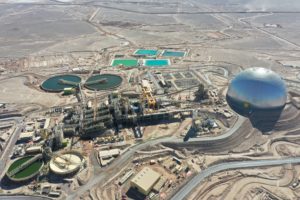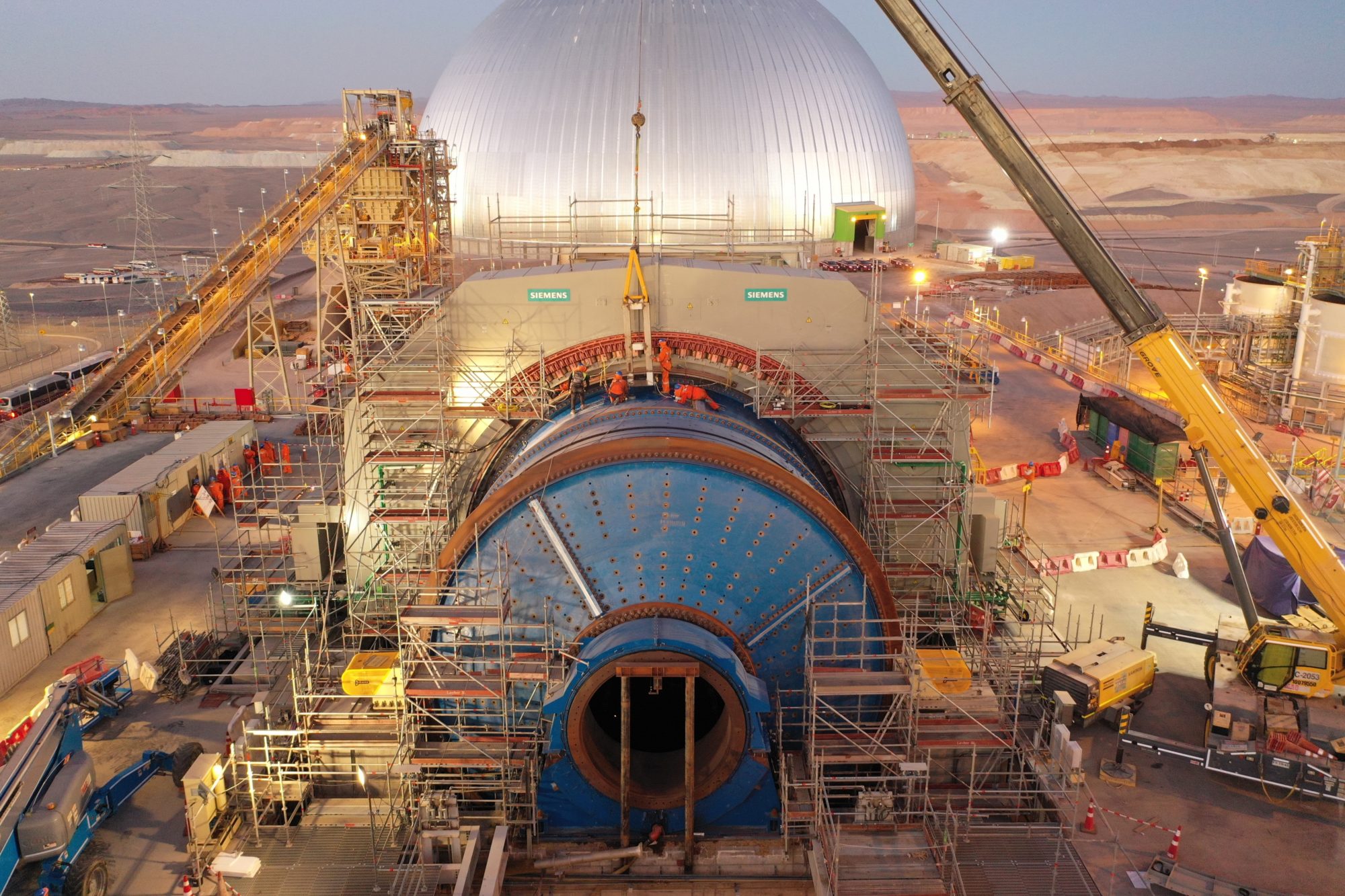The Spence Growth Option (SGO) is a key project for BHP’s future portfolio and for Minerals Americas. SGO will extend the useful life of Spence for another 50 years and will produce essential resources required for the aspirations and challenges of the futureworld. Thus, SGO will allow BHP to increase its contribution to the Antofagasta Region and to Chile. The project involves a new concentrator plant that will produce an average of 185,000 t per year of copper in concentrate in its first 10 years of operation.
The US$2.46 billion investment project has employed more than 5,000 people during its construction and is expected to start operations in 2021. From a deposit point of view, the Spence hypogene sulphide mineral resources and ore reserves are a downward, continuous extension of the currently exploited supergene oxide and sulphide mineral resources and ore reserves. The supergene oxide and sulphide material is currently processed in a leaching operation whereas the hypogene sulphide material will provide ore feed to a new conventional sulphide milling and flotation concentrator plant.
IM spoke to BHP about the SGO project with a focus on innovations being applied as part of the expansion.
The project is now looking at start up in 2021 due to COVID-19 mainly and a reduced site workforce. Despite this have you been able to still make progress using strategies like virtual meetings with key technology suppliers and a modular approach to construction?
Owing to the support of all our contractor companies, and especially their workers, we have been able to continue implementing the project despite the pandemic. We have adopted measures to prevent infections of workers such as the use of masks and respirators, establishment of hygiene and social distancing measures in common areas like dining halls and transportation, as well as preventive testing prior to working at site. We want to highlight the commitment of the entire project team, which applied these new controls rigorously. Additionally, with the support of technology, we were able to keep our at-risk workers away from site but actively participating virtually in all required activities. This technology has also allowed us to work with different suppliers from other parts of the world.

What is the status of the desalination plant progress and has the use of desalinated water meant there have had to be any special adaptations in the processing plant?
All fresh water supply for the SGO project will come from a new and efficient seawater desalination plant, which will produce 86,000 cubic metres a day. SGO was developed and designed from the start with this imperative, drawing on the experience of Minera Escondida, which constructed its Organic Growth Project (OGP1), comprising a new concentrator plant, and its Escondida Water Supply (EWS) project, involving a 2,500 litre per second desalination plant to cover increased processing. In the case of SGO, this strategic water project was built, financed and will be operated by a third party under the BOOT model (Build, Own, Operate and Transfer). It is currently in the final stages of commissioning, during which it has already supplied about 1 million cubic metres of water to its mine-delivery point.
To what extent will Spence be managed operationally from the Remote Operations Centre in Santiago and has COVID meant an even greater focus on things like predictive maintenance and remote monitoring?
The Centre of Integrated Operations (CIO) began operating in Santiago in July 2019, including among its tasks the control and monitoring of Spence’s mine and leach circuit operations. During the commissioning stage, SGO was controlled from rooms installed on site. The transition to the CIO is expected when the ramp-up stage is advanced in the first half of calendar year 2021. During COVID, the CIO has enabled greater flexibility in the control and monitoring of operations and in the integrity of assets, ensuring operational continuity in a safe environment and with high standards of hygiene control.
On the mining side, BHP is investing in autonomous trucks and drills at other operations around the world, and has said this is under consideration at Spence. Can you give any more details or updates?
It is a possibility that we are evaluating, as well as other alternatives that allow us to better face the challenges of the industry and, specifically, of our deposit. Remaining competitive and sustainable in a scenario of older deposits, lower grades and greater distances from the ore, requires us to seek new ways of mining. As a result, the operation of autonomous equipment is part of the different alternatives we are studying. It should be noted that automation, in addition to improving productivity, makes it possible to continue improving the safety and wellbeing of people, as well as how the industry’s present and future environmental challenges are addressed.
I understand that a modular approach was used for the primary crushing station, can you outline any design details and why this was done?
We have a fixed crusher made of a mixed structure of concrete and steel. It is important to note that we used a crusher purchased for another application and adapted it for this project. The entire supporting structure was purchased by our EPC (Engineering, Procurement and Construction) contractor in Thailand and brought over in modular form, which avoided exposing workers at site and allowed construction to progress very fast.

SGO also includes a new approach to flotation technology using Staged Flotation Reactors – can you give any details on why this was chosen?
Indeed, one of the technological innovations implemented was in the flotation process, for both the copper and molybdenum production processes. The use of this new technology has allowed us to install the cells in a much smaller physical area than conventional flotation and lower construction costs as well as energy consumption.
Health and safety is a big part of SGO as well as productivity. Have you invested in any technology to keep workers safe at SGO such as collision avoidance or fatigue management tools?
SGO is a BHP project and, as such, safety is a top priority as one of the fundamental values of our company’s Charter. We have worked in an integrated and collaborative way with all the companies that have participated in this project to ensure that everyone can return safely to their homes. At SGO all workers have had and still have an unrestricted commitment to safety. It is a non-negotiable value.In addition to our strong safety culture, we rely on technology to reinforce our safety measures. For example, the Centre of Integrated Monitoring records all project vehicle movements and, additionally, we have reduced smaller vehicles so that trips are covered by professional drivers to reduce exposure to this material risk.
Are there any other innovations in the journey so far with the SGO project you would highlight?
It is difficult to summarise almost five years of work. As an innovation, our business model and project execution strategy has been unique in its kind, mainly because we have allowed specialists to define how they will carry out the work to address the project’s requirements. For example, vertical packages on specialist subjects and an integration contractor has allowed us to implement a contracting model where specialist companies assume responsibility for the performance of their EPC-delivered facilities. Another SGO innovation was the incorporation of a technology suite. This enabled the development of an integrated intelligent engineering design, which was systematically integrated with the materials procurement platform and, in turn, with the programming and construction platform. In this way, we were able to reduce efforts to control the progress of the project stages, in addition to improving the accuracy of acquisitions. Finally, it is worth highlighting the advances in Inclusion and Diversity. The new concentrator team at Spence was assembled with the ambition of achieving gender balance and we are proud to have met this goal: today we have gender parity in this area, marking a milestone in the mining industry in Chile.











